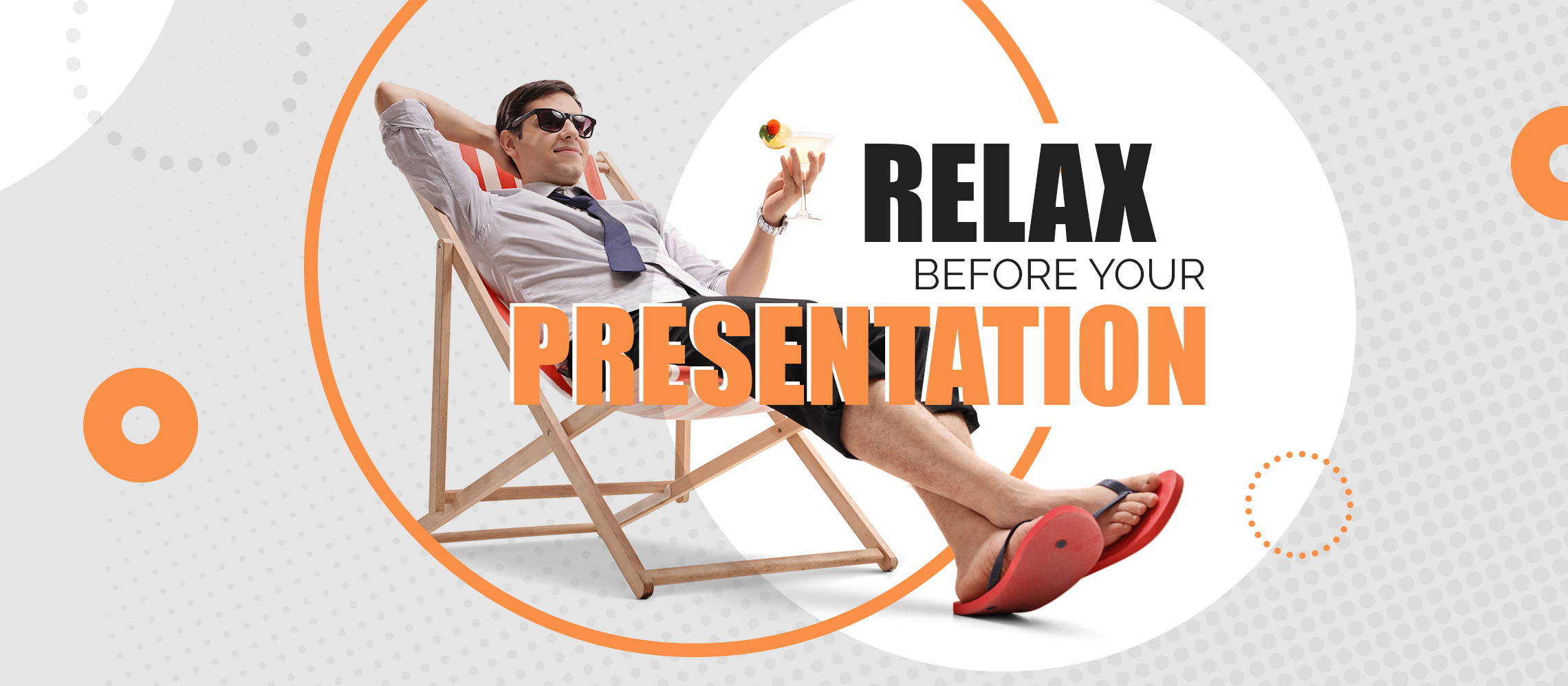How to relax before a presentation with seven fast-acting remedies to natural nerves.
A month ago, your boss called you into his office and entrusted you with representing the entire company at an industry exhibition. He explained how important your ideas have been to the development of the business, and how he wanted you to share these ideas with your peers by presenting at the event.
While the elation was still wearing off, you got started planning out your key messages. You created a critical path, depicting every moment of your time between that meeting and the moment you were to step on the stage.
You’ve worked with a specialist presentation design agency to refine your story and create a set of slides that look incredible. You have practiced in your head on the bus, out loud in front of your mirror, and out louder in front of a room full of your colleagues. You know this presentation inside out, you have your perfect outfit picked out and hanging up ready for the big day tomorrow. Your preparations have been run like a military operation, so why are you sat at your computer, less than twelve hours before you need to present, Googling how to relax before a presentation?

You’ve been so focused on planning and rehearsing, you haven’t had a moment to check in with yourself. Now that you’ve finally stopped to breathe, the nerves have run through you like a cannonball. It’s lucky you found us. Stop panicking that it’s too late to conquer these late-onset wobbles, and stop thinking about running away and starting a new life just to avoid those dreaded twenty minutes on stage. By the end of this article you’ll know how to relax before your presentation.
How to relax before a presentation
Convert your energy
Set your alarm just an hour earlier tomorrow and get yourself to the gym. By exercising on the morning of your presentation, you can alleviate anxiety through elevated endorphins, but exercise can do so much more than this.

Have you ever noticed how nervous energy and excited energy have the same symptoms? Your heart pounds, your pulse quickens, and your hands get clammy. The only difference between these two states is your perception of the situation, and the thoughts running through your brain.
By ignoring the negative thoughts and focusing on the positive, you can learn to control your emotions. Exercise can help you to channel your nervous energy, relax and flip the emotional switch to create a more positive presentation persona. And enthusiastic presentations can be even more persuasive than eloquent ones. Enthusiasm is contagious, so rather than trying to slow your pulse and quieten your racing heart, use this energy to get the whole room pumped.
Early bird ditches the nerves
While it would certainly leave an impression, turning up late to your own presentation might get tongues wagging for the wrong reasons. I’m sure ‘unreliable’ isn’t the image of the company your boss wants you to portray.
Remove even the possibility of this extra level of stress by arriving in plenty of time. This also allows you to acclimatise to the environment and meet a few of your audience members. Take the time to assess the room for potential distractions to prepare yourself and make sure they don’t catch you by surprise mid-sentence.
Once you’ve completed your reconnaissance mission and feel at home in the space, you can spend some time in the bathroom cubicle, working on tip three.
Strike a pose
Anyone who has ever watched a movie knows about the power of heroes in storytelling. But what about the power of heroes in presenting?
In just two minutes, you can learn to be your own hero on that stage. It’s easy: just give me your best Wonder Woman impression. Place your feet wider than hip-distance apart, hands on hips, elbows pointing outwards, head raised and chest pushed forward.

OK, doing this in front of a room full of people isn’t the strategy I’m going to suggest for you, you’ll be pleased to hear. We can all learn from the mistakes of Conservative politicians. But this pose could be the answer to your public speaking worries.
In her wildly successful TED talk, non-verbal communication expert Amy Cuddy talks about power dynamics, and how you really can ‘fake it ‘til you make it’ when it comes to confidence. Cuddy tells us that, when we feel inferior, or uncomfortable, we naturally shrink, as if we’re trying to become invisible. And it’s a vicious cycle. The smaller we become, the smaller we feel. I want you to take just two minutes to stop the cycle.
Before you are due to present, find a quiet place, such as a bathroom stall, and practice the ‘Wonder Woman’ pose. Take up as much space as possible, as much space as you deserve, and hold the pose for two minutes. Then strut onto that stage with your head held high.
If you want to incorporate a whip, that’s none of my business.
Drink (water – be sensible now)
As if fear itself isn’t enough of a distraction, it comes with a whole host of extra bodily consequences. One of these unwelcome reflexes is a mouth as dry as the Sahara.
Throughout the morning, make sure you drink regularly to stop cottonmouth attacking, and keep a bottle at arm’s reach while you’re presenting to keep your hydration levels topped up.
Use your imagination
When training for a title fight, you expect boxers to train their bodies, but did you know the biggest names in boxing also train their minds? Visualisation has become common practice across many sports in recent years, and you can apply these techniques to your morning preparation as well.
Instead of thinking you’re going to trip up, forget your words, and PowerPoint is going to crash, you can relax by visualising a captivated audience, every one of your jokes being received with raucous laughter, and a standing ovation at the end of your presentation. Not only will these positive thoughts calm your nerves, visualising a successful presentation is likely to actually result in one.
Take a pause
A wobbly voice and lightning-fast speech can be a big giveaway that you’re nervous and, when you’re presenting, it can be hard for your audience to follow. By practicing breathing techniques, you can focus on stabilising your rate of breath, and calming your nerves at the same time.

Breathing techniques provide a rhythm for you to follow and help you to find balance, fast. You can use audio guides, such as Youper, to help you find the perfect rhythm when you’re just starting out. After some practice, you’ll be able to call on these learned behaviours any time you feel the nerves building.
If you don’t have access to an audio assistant, a general rule is to breathe in for five seconds, hold for two seconds, then exhale for seven seconds.
Acknowledge the nerves
Admitting to your audience that you’re nervous is endearing and can actually be a strong presentation opener. Starting your set with this admission creates a bond, gets them all rooting for you, and also gets the elephant removed from the exhibition room. According to Chris Anderson, curator of TED, “if you go on stage and you’re still feeling nervous, it’s okay just to tell the audience that. Audiences like honesty.”
Make sure that you don’t dwell on the emotion though, as it will only make everyone uncomfortable the longer it goes on. Just reach out to their natural human empathy, then move on with the content they all came to see.
See, we told you there was no reason to panic. Now you can stop worrying, get a peaceful night’s sleep and relax before your presentation, knowing that every action you need to take to feel confident on stage can be put on tomorrow’s to-do list. Just remember to set your alarm early and, if you happen to be able to control your dreams, start visualising being carried out of the exhibition on the shoulders of your adoring audience while you sleep.


